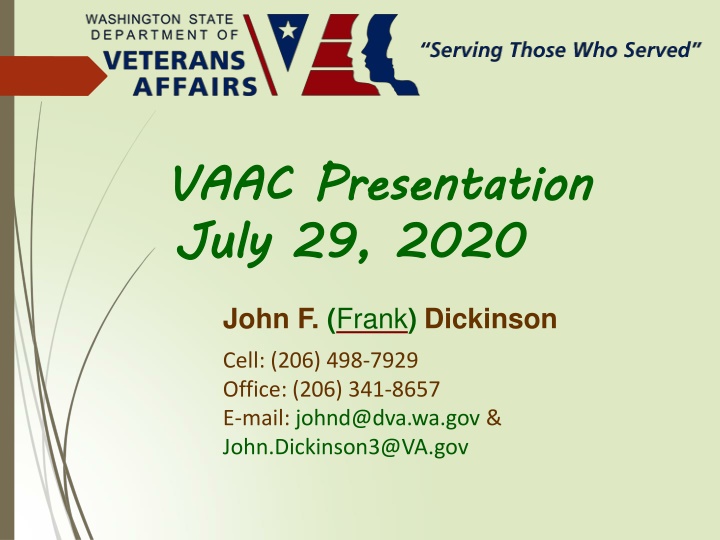
VA Disability Compensation: Benefits and Eligibility
Learn about VA disability compensation, including service-connected disabilities, compensation rates, and eligibility criteria. Discover how veterans can receive monthly tax-free payments for injuries or illnesses related to military service.
Download Presentation

Please find below an Image/Link to download the presentation.
The content on the website is provided AS IS for your information and personal use only. It may not be sold, licensed, or shared on other websites without obtaining consent from the author. If you encounter any issues during the download, it is possible that the publisher has removed the file from their server.
You are allowed to download the files provided on this website for personal or commercial use, subject to the condition that they are used lawfully. All files are the property of their respective owners.
The content on the website is provided AS IS for your information and personal use only. It may not be sold, licensed, or shared on other websites without obtaining consent from the author.
E N D
Presentation Transcript
VAAC Presentation July 29, 2020 VAAC Presentation July 29, 2020 John F. (Frank) Dickinson Cell: (206) 498-7929 Office: (206) 341-8657 E-mail: johnd@dva.wa.gov & John.Dickinson3@VA.gov
What We Will Cover Service Connected Disability Compensation Dependency & Indemnity Compensation Non-service Connected Pension Survivor Pension
Service Connected Disability The term "Service-Connection" means that a particular chronic disease or residual of aninjury, resulting in continued disability was incurred as the result of military service. Service- Connection can be granted for two different types of disability: Residuals of Injury must have left an identifiable residual (i.e. a scar from a gunshot wound, or traumatic arthritis from a joint) chronically disabling may be serviceconnected. Chronic Disease is any disease diagnosedas Eligibility You may be eligible for disability compensation if: You have a service-related disability or illness. Your discharge was not dishonorable.
Service Connected Disability Compensation VA disability compensation (pay) offers a monthly tax-free payment to Veterans who became sick or were injured while serving in the military or to Veterans whose service made an existing condition worse (aggravated). You may qualify for VA disability benefits for physical conditions (like a chronic illness or injury) and mental health conditions (like PTSD) that developed before, during, or after service.
Basis for Establishment of Service Connection Direct Basis Aggravation Secondary Basis Due to Undiagnosed Illness Presumptive Basis
How Does VA Calculate Compensation Rates? The amount of basic benefit paid varies, depending on how disabled the veteran is (how severe the disability). VA makes a determination about the severity of a disability based on the evidence submitted as part of the claim, or that which VA obtains from the veteran s military records. VA rates disability from 0% to 100% in 10% increments (e.g. 10%, 20%, 30% etc.). You may be paid additional amounts, in certain instances, if: You have very severe disabilities or loss of limb(s) You have a spouse, child(ren), or dependent parent(s) You have a seriously disabled spouse
Combined Ratings If VA finds that a Veteran has multiple disabilities, VA uses the Combined Ratings Table (next slide) to calculate a combined disability rating. Disability ratings are not additive, meaning that if a Veteran has one disability rated 60% and a second disability 20%, the combined rating is not 80%. This is because subsequent disability ratings are applied to an already disabled Veteran, so the 20% disability is applied to a Veteran who is already 60% disabled.
DIC (Dependency Indemnity Compensation) Dependency and Indemnity Compensation (DIC) is a tax free monetary benefit generally payable to a surviving spouse, child, or parent of servicemembers who died while on active duty, active duty for training, or inactive duty training, or survivors of Veterans who died from their service- connected disabilities, or The Veteran didn t die from a service-connected illness or injury, but was eligible to receive VA compensation for a service-connected disability rated as totally disabling for a certain period of time.
Pension (Non-Service Connected Disability) Pension is a needs-based benefit program for wartime Veterans, Who are age 65 or older or Have a permanent and total non-service connected disability, and Who have limited income and net worth. Veterans who are more seriously disabled may qualify for pension at the increased housebound or aid and attendance rates.
Pension (Non-Service Connected Disability) Periods of War for Pension Eligibility Under current law, VA recognizes the following wartime periods to decide eligibility for VA pension benefits: Mexican Border period (May 9, 1916, to April 5, 1917, for Veterans who served in Mexico, on its borders, or in adjacent waters) World War I (April 6, 1917, to November 11, 1918) World War II (December 7, 1941, to December 31, 1946) Korean conflict (June 27, 1950, to January 31, 1955) Vietnam War era (February 28, 1961, to May 7, 1975, for Veterans who served in the Republic of Vietnam during that period. August 5, 1964, to May 7, 1975, for Veterans who served outside the Republic of Vietnam.) Gulf War (August 2, 1990, through a future date to be set by law or presidential proclamation)
A&A and Housebound VA Aid and Attendance or Housebound benefits provide monthly payments added to the amount of a monthly VA pension for qualified Veterans and survivors. You qualify for VA Aid and Attendance if you need another person to help you perform daily activities, like bathing, feeding, and dressing. You qualify for Housebound if you get a VA pension and you spend most of your time in your home because of a permanent disability (a disability that doesn t go away), or you are in a nursing home.
Survivors Pension (Death Pension) Survivors Pension, which was formerly referred to as Death Pension, is a tax-free benefit payable to a low- income, un-remarried surviving spouse or unmarried child(ren) of a deceased Veteran with wartime service. It is a needs based benefit and calculated using the claimant s net worth and Income.






















